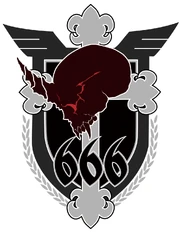(→Trivia) |
|||
| (29 intermediate revisions by 13 users not shown) | |||
| Line 1: | Line 1: | ||
| − | [[File:Black_mark.png|thumb|There is no such thing as a price too great to pay.]]The |
+ | [[File:Black_mark.png|thumb|There is no such thing as a price too great to pay.]]The [[Eastern_European_Socialist_Alliance#Deutsche_Demokratische_Republik|GDR's]] '''666<sup>th</sup> TSF Squadron ''Schwarzesmarken''''' are a special forces unit of the [[Eastern_European_Socialist_Alliance#Nationale_Volksarmee|NVA's]] Special Composite Air Group ''Hannibal ''stationed at Cottbus Base, deployed in the defence of the Oder-Neisse line. Operating mostly [[MiG-21 Balalaika|MiG-21s]] and an [[MiG-21_Balalaika#MiG-21PF|MiG-21PF]] assigned to their commander, Captain [[Irisdina Bernhard]], they are often deployed as [[BETA#Laser-class|Lux]] and [[BETA#Heavy_laser-class|Magnus Lux]] interdictors; their mission is ''[[Combat_Doctrine#Laserjagd|laserjagd]]'', meaning "laser hunt" in German. |
| + | The eradication of the [[BETA|BETA's]] laser strains is important to the NVA [[Combat_Doctrine#Static_Defence|as a whole]]; the loss of laser cover means that the BETA can be easily eradicated with artillery and aerial bomber cover, and the 666<sup>th</sup> often has to race against time even as the fortifications of the Oder-Neisse line wear down with every assault. |
||
| − | The 666th Squadron mostly operates [[MiG-21 Balalaika|MiG-21s]], with their squadron commander [[Irisdina Bernhard]] piloting an [[MiG-21_Balalaika#MiG-21PF|MiG-21PF]]. |
||
| − | ==Operational History== |
||
| − | When deployed by the East German Army, the 666th's primary goal is the eradication of Lux-class BETA during an offensive to sanitize the airspace from BETA threats, allowing reinforcements and supplies to be easily delivered in and the injured evacuated posthaste. |
||
| + | As such, the 666<sup>th</sup> give their main orders the topmost priority; it is common practice for them to ignore allied distress calls that will result in deviation from their original mission, even if only for a short moment. Such actions have earned them many unflattering nicknames amongst the troops of the NVA. |
||
| − | They are later assigned to Operation Neptune, part of a joint-UN/US/EU/Warsaw Pact task force aimed at countering the BETA advance across Europe with any means possible, starting with landing a force at the Gulf of Gdansk. |
||
| + | |||
| ⚫ | |||
| + | In the aftermath of Operation St Ursula, Theodor Eberbach was made the commander of the 666th after it was officially reconstituted under the new East German government. Anett remained his subordinate as the both of them worked toward Irisdina's ideal for a powerful and safe East Germany, fighting on the front lines against the BETA throughout Europe's slow withdrawal from the mainland. |
||
| − | *1983: Participates in Operation Neptune. |
||
| ⚫ | |||
| + | *10<sup>th</sup> January, 1983: Successful completion of a target-interdiction ''laserjagd'' mission some distance from the Bóbr river, in support of allied forces defending the Oder-Neisse defense line. |
||
| + | *16<sup>th</sup> January, 1983: Supporting the defenders of the Oder-Neisse line, the 666<sup>th</sup> stage an ambush from the Oder River on a second incoming BETA force, hitting its north flank in conjunction with other NVA TSF units attacking from different directions. |
||
| + | *8<sup>th</sup> March, 1983: Participates in [[Operation Neptune]] alongside [[European Union|European]] and [[United Nations|UN]] forces, being amongst the first in the force to reach the shores of the Gulf of Gdansk. |
||
==Members== |
==Members== |
||
| + | ===Main Flight=== |
||
{| width="100%" |
{| width="100%" |
||
|- valign="top" |
|- valign="top" |
||
| + | |<gallery position="center" spacing="small" widths="200" captionalign="center" captionsize="medium"> |
||
| − | | |
||
| + | 1337187811048.jpg|Captain, [[Irisdina Bernhard]]. Schwarz-1. |
||
| − | *[[Anett Hosenfeld]] |
||
| + | Walther VN Cockpit.jpg|1st Lieutenant, [[Walther Kruger]]. Staff Officer of the 666th. Schwarz-3. |
||
| − | *[[Irisdina Bernhard]] |
||
| − | + | Cover 05.jpg|1st Lieutenant, [[Gretel Jeckeln]]. Political Commissar. Schwarz-4. |
|
| + | 0E120E68.png|2nd Lieutenant, [[Theodor Eberbach]]. Schwarz-8. |
||
| − | *[[Katia Waldheim]] |
||
| + | </gallery> |
||
| − | *[[Pham Thi Ran]] |
||
| + | ===Rearguard Flight=== |
||
| − | *[[Sylvia Krzasińska]] |
||
| + | |||
| − | *[[Theodore Edelbach]] |
||
| + | <gallery position="center" captionalign="center" widths="200" spacing="small"> |
||
| − | *[[Walter Kruger]] |
||
| + | Pham Piloting.jpg|1st Lieutenant, [[Pham Thi Lan]]. Second-in-command. Schwarz-2. |
||
| − | *[[Lyz Hohenstein]] |
||
| + | Wordner-img600x406-1397910005eobvb817431.jpg|2nd Lieutenant, [[Sylwia Krzasińska]]. Schwarz-5. |
||
| + | Inghildbronikowski.jpg|2nd Lieutenant, [[Inghild Bronikowski]]. Schwarz-7. |
||
| + | SchwarzesmarkenVol1.jpg|2nd Lieutenant, [[Katia Waldheim]]. Schwarz-7's replacement. |
||
| + | Anett VN Cockpit.jpg|2nd Lieutenant, [[Anett Hosenfeld]]. Schwarz-6. |
||
| + | SchwarzesmarkenVol3.jpg|2nd Lieutenant, [[Lise Hohenstein]]. Schwarz-2's replacement. |
||
| + | </gallery> |
||
| + | ==Equipment== |
||
| + | |||
| + | |||
| + | |||
| + | |||
| + | <gallery widths="225" position="center" spacing="small" captionalign="center"> |
||
| + | MiG-21PF lineart.png|MiG-21PF, Irisdina Bernhard's commander unit. |
||
| + | MiG-21.jpg|[[MiG-21 Balalaika]], the standard TSF of the NVA circa 1983. |
||
| + | </gallery> |
||
| + | ==Trivia== |
||
| |
| |
||
| |
| |
||
|} |
|} |
||
| + | *<span style="font-weight:normal;line-height:21px;">The name of their squadron, </span>''Schwarzesmarken''<span style="font-weight:normal;line-height:21px;">, which translates to Black Marks, is a reference to the color tags used by combat medics to identify the severity of injuries of individual soldiers at a field triage. Yellow refers to minor injuries, red for life-threatening, and as reflected by the squadron's actions of ignoring assistance requests, black is for those beyond saving.</span> |
||
| + | **<span style="font-weight:normal;line-height:21px;">The name ''Schwarzesmarken'', despite being grammatically incorrect in German, was kept because it was coined by an influential Soviet officer and has since been kept as a matter of pride. </span>The correct name would have been ''Schwarzes Zeichen.'' |
||
[[Category:Schwarzesmarken]] |
[[Category:Schwarzesmarken]] |
||
[[Category:Military Units]] |
[[Category:Military Units]] |
||
| + | [[Category:TSFIA]] |
||
Revision as of 05:59, 12 November 2018

There is no such thing as a price too great to pay.
The GDR's 666th TSF Squadron Schwarzesmarken are a special forces unit of the NVA's Special Composite Air Group Hannibal stationed at Cottbus Base, deployed in the defence of the Oder-Neisse line. Operating mostly MiG-21s and an MiG-21PF assigned to their commander, Captain Irisdina Bernhard, they are often deployed as Lux and Magnus Lux interdictors; their mission is laserjagd, meaning "laser hunt" in German.
The eradication of the BETA's laser strains is important to the NVA as a whole; the loss of laser cover means that the BETA can be easily eradicated with artillery and aerial bomber cover, and the 666th often has to race against time even as the fortifications of the Oder-Neisse line wear down with every assault.
As such, the 666th give their main orders the topmost priority; it is common practice for them to ignore allied distress calls that will result in deviation from their original mission, even if only for a short moment. Such actions have earned them many unflattering nicknames amongst the troops of the NVA.
In the aftermath of Operation St Ursula, Theodor Eberbach was made the commander of the 666th after it was officially reconstituted under the new East German government. Anett remained his subordinate as the both of them worked toward Irisdina's ideal for a powerful and safe East Germany, fighting on the front lines against the BETA throughout Europe's slow withdrawal from the mainland.
Operation Dates
- 10th January, 1983: Successful completion of a target-interdiction laserjagd mission some distance from the Bóbr river, in support of allied forces defending the Oder-Neisse defense line.
- 16th January, 1983: Supporting the defenders of the Oder-Neisse line, the 666th stage an ambush from the Oder River on a second incoming BETA force, hitting its north flank in conjunction with other NVA TSF units attacking from different directions.
- 8th March, 1983: Participates in Operation Neptune alongside European and UN forces, being amongst the first in the force to reach the shores of the Gulf of Gdansk.
Members
Main Flight
Captain, Irisdina Bernhard. Schwarz-1. 1st Lieutenant, Walther Kruger. Staff Officer of the 666th. Schwarz-3. 1st Lieutenant, Gretel Jeckeln. Political Commissar. Schwarz-4. 2nd Lieutenant, Theodor Eberbach. Schwarz-8. Rearguard Flight1st Lieutenant, Pham Thi Lan. Second-in-command. Schwarz-2. 2nd Lieutenant, Sylwia Krzasińska. Schwarz-5. 2nd Lieutenant, Inghild Bronikowski. Schwarz-7. 2nd Lieutenant, Katia Waldheim. Schwarz-7's replacement. 2nd Lieutenant, Anett Hosenfeld. Schwarz-6. 2nd Lieutenant, Lise Hohenstein. Schwarz-2's replacement. EquipmentMiG-21 Balalaika, the standard TSF of the NVA circa 1983. Trivia |
- The name of their squadron, Schwarzesmarken, which translates to Black Marks, is a reference to the color tags used by combat medics to identify the severity of injuries of individual soldiers at a field triage. Yellow refers to minor injuries, red for life-threatening, and as reflected by the squadron's actions of ignoring assistance requests, black is for those beyond saving.
- The name Schwarzesmarken, despite being grammatically incorrect in German, was kept because it was coined by an influential Soviet officer and has since been kept as a matter of pride. The correct name would have been Schwarzes Zeichen.












